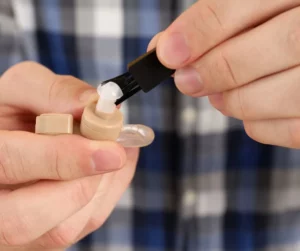Understanding How To Clean Hearing Aids for Best Performance

Investing in hearing aids signifies a commitment to improved hearing. While these devices are designed for durability, their performance and longevity largely depend on proper maintenance. Failing to care for your hearing aids can result in sound quality degradation, decreased lifespan, and potential malfunctions. Proactive upkeep helps avoid these pitfalls and prolongs the utility of your investment.
Why is Maintenance Essential?
- Better Sound Quality: Regular cleaning prevents earwax, dirt, and moisture from clogging the sound ports, thus ensuring a clearer auditory experience.
- Extended Device Lifespan: Timely maintenance protects your hearing aids from environmental factors such as moisture and dust, thus maximizing their longevity.
- Skin Health: Keeping the hearing aids clean minimizes the risk of skin irritations and infections.
- Peak Performance: Consistent visits to your audiologist ensure that your hearing aids function correctly, maximizing your benefit from the devices.
- Cost-Efficiency: Proper upkeep can save you from the high costs of repairs or replacements.
Consequences of Inadequate Maintenance:
- Sound Obstruction: Earwax buildup can block sound ports, affecting your ability to hear clearly.
- Technical Failures: Lack of care can result in moisture corroding internal components, leading to malfunctions.
- Compromised Sound Clarity: Accumulated dirt and dust can compromise microphone efficiency, affecting sound quality.
- Battery Complications: Battery issues can cause feedback or distortions, making regular check-ups essential.
If you experience changes in performance, such as reduced sound clarity, seek professional inspection and cleaning immediately. Long-term success with hearing aids requires ongoing, diligent care.
Understand more about proactive hearing care.

How To Clean Your Hearing Aids Daily
Proper daily care of your hearing aids is crucial for their optimal performance and durability. Below is a detailed guide on how to clean hearing aids. We also have videos on how to clean your hearing aids.
Daily Hearing Aid Maintenance Checklist
- Hand Hygiene: Wash your hands before handling your hearing aids to minimize dirt or oil transfer.
- Initial Clean: Wipe down the aids with a soft cloth each time you remove them, focusing on the microphone, earphone, and vent areas.
- Dry Storage: Store your hearing aids in a designated dry container or a dehumidifier when not in use.
- Avoid Water: Remove your hearing aids before bathing, swimming, or using hairspray unless they are explicitly waterproof.
- Health Precautions: Don’t wear your hearing aids if you have an ear infection or while sleeping.
- Wax Mechanisms: Check any built-in wax cleaning features daily, as advised during your fitting.
- Expert Consultation: Discuss maintenance accessories with your audiologist.
See our video library for more details.
Type-Specific Cleaning Guidelines
Follow these sequential steps for a practical hearing aid maintenance checklist for cleaning your In-The-Ear (ITE) hearing aids.
- Position & Remove: Hold the device facing downward and remove it from your ear.
- Brush: Gently brush the microphone, cover, and vents.
- Wax Pick: Use a wax pick for stubborn debris.
- Vent Cleaning: Use a vent cleaner, wiping it clean before retracting.
- Filter: Gently brush the wax filter to clear blockages.
- Final Clean: Wipe down the device with a dry cloth. Avoid water or chemicals.
Here is a tailored hearing aid maintenance checklist for Over-The-Ear (OTE) and rechargeable hearing aids.
- Removal: Extract the device from your ear.
- Brushing: Clean the microphone, device, and ear mold while facing downward.
- Wax Removal: Use a wax pick for hard-to-reach debris.
- Vent Cleaning: Slide a vent cleaner through the vents, wiping it clean before retracting.
- Ear Mold: Detach, soak in warm, soapy water, and dry thoroughly before reassembling.
- Rechargeable Hearing Aids
- Daily Wipe: Use a soft, dry cloth for cleaning. Avoid water or chemicals.
- Charging Contacts: Clean the contacts in the charger with a soft brush.
- Safe Storage: Place the hearing aids in their charging station when not in use.
- Moisture Caution: Dry immediately if exposed to moisture
- Port Checks: Inspect and clean the microphone and sound ports regularly.
Understanding how to clean hearing aids is crucial for their longevity and optimal performance, regardless of the type you own.
Read here for more information on different types of hearing aids.
Protecting Your Hearing Aids
To prolong the life of your hearing aids, store them in a designated case or charging unit when not in use. Avoid exposing them to moisture, chemicals, or extreme temperatures. Handle them with care to prevent accidental drops or rough handling.
Maintaining your hearing aids guarantees their longevity and performance. Explore the latest trends in hearing aid technology to find the best fit for your needs.

How To Clean Hearing Aids With Professional Support
For optimal performance and longevity, your hearing aids need more than just daily at-home care. Regular visits to Stanford Hearing Aids for professional maintenance are crucial. These devices are often exposed to wax and moisture because they are in the ear canal. The risk of damage increases the deeper the aids sit in the ear canal. It’s vital to have professional support so you know how to clean hearing aids effectively.
Specialized Tools and Expertise
Certified audiologists at Stanford Hearing Aids employ specialized vacuums and attachments to remove hard-to-reach wax. We can also safely clean key components like vents, microphone screens, windscreens, and receivers.
Consequences of Not Getting Support in Hearing Aid Maintenance
Ignoring professional care can result in several problems:
- Volume: A decline in volume, either sudden or gradual.
- Clarity: Reduced clarity in high-frequency sounds, causing muffled or distorted audio.
- Feedback: Unwanted ‘whistling’ sounds from the device.
- Blockages: Tubes may get blocked, affecting performance.
Quarterly Professional Check-Ups
Schedule a professional cleaning every three months to avoid these issues. Audiologists also conduct essential inspections and calibrations during these visits to ensure your devices are at their best.
The Importance of Hearing Aid Maintenance
Adhering to professional maintenance guidelines ensures higher sound quality and fewer disruptions, enhancing your overall quality of life. Your hearing health is vital. For expert advice or more information on maintaining your hearing aids, contact Stanford Hearing Aids. Our knowledgeable team is eager to assist you in maximizing your hearing aid investment.
